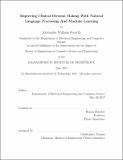Improving clinical decision making with natural language processing and machine learning
Author(s)
Forsyth, Alexander William
DownloadFull printable version (807.9Kb)
Other Contributors
Massachusetts Institute of Technology. Department of Electrical Engineering and Computer Science.
Advisor
Regina Barzilay.
Terms of use
Metadata
Show full item recordAbstract
This thesis focused on two tasks of applying natural language processing (NLP) and machine learning to electronic health records (EHRs) to improve clinical decision making. The first task was to predict cardiac resynchronization therapy (CRT) outcomes with better precision than the current physician guidelines for recommending the procedure. We combined NLP features from free-text physician notes with structured data to train a supervised classifier to predict CRT outcomes. While our results gave a slight improvement over the current baseline, we were not able to predict CRT outcome with both high precision and high recall. These results limit the clinical applicability of our model, and reinforce previous work, which also could not find accurate predictors of CRT response. The second task in this thesis was to extract breast cancer patient symptoms during chemotherapy from free-text physician notes. We manually annotated about 10,000 sentences, and trained a conditional random field (CRF) model to predict whether a word indicated a symptom (positive label), specifically indicated the absence of a symptom (negative label), or was neutral. Our final model achieved 0.66, 1.00, and 0.77 F1 scores for predicting positive, neutral, and negative labels respectively. While the F1 scores for positive and negative labels are not extremely high, with the current performance, our model could be applied, for example, to gather better statistics about what symptoms breast cancer patients experience during chemotherapy and at what time points during treatment they experience these symptoms.
Description
Thesis: M. Eng., Massachusetts Institute of Technology, Department of Electrical Engineering and Computer Science, 2017. This electronic version was submitted by the student author. The certified thesis is available in the Institute Archives and Special Collections. Cataloged from student-submitted PDF version of thesis. Includes bibliographical references (pages 49-53).
Date issued
2017Department
Massachusetts Institute of Technology. Department of Electrical Engineering and Computer SciencePublisher
Massachusetts Institute of Technology
Keywords
Electrical Engineering and Computer Science.